Dee Estuary Birding
Monthly Newsletter...
August 2022 Newsletter
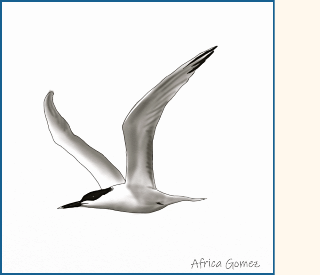
Flying off to Iceland in May to
follow migrating Red Knot
It was an early morning on the 3rd of May this year
and we were at the edge of the incoming tide at Southport. We were
looking for colour marked Red Knot during the last few days before the
adults departed northwards, first to their staging grounds in Iceland
and then after fattening up, to Arctic Canada and Greenland to breed.
This is usually a sad time for us as we lose most of the waders except
those born last year so there are not so many to enjoy. This year,
however, we were following them to Iceland, but not before witnessing
their northerly departure. This is an amazing show not seen often as
you need to be in the right place at the right time. We were lucky this
year. The Knot flock we were studying were extremely vocal, making
their distinctive pre-migration ‘whit-whit’ calls. Some had stopped
feeding but were still calling and suddenly a group took off on a north
westerly bearing and climbed higher and higher until we could no longer
see them. Over several days the beach grew quieter and quieter as each
small group departed until we were left with the mainly young grey
birds.
A week later we too were in Iceland as part of a team of nine. Our trip
was to first take in the southwest Iceland coast between Keflavik
Airport and Snaefellsjökull, concentrating our effort between Akranes
and Skogarnes; and then to go to the more rugged northwest of Iceland.
Our group’s purpose was to read as many colour marked Red Knot as
possible, and if the conditions were right to colour mark some more.
Hence the team was composed of both seasoned colour mark readers and
those experienced in catching and marking. Data collected would
contribute to our understanding of the impact of environmental
pressure, including avian influenza, on mortality / survival as well as
to further understand the migration paths of Red Knot, especially those
Knot colour marked in the Liverpool Bay area. The last is important as
there is an acute awareness that to protect these vulnerable waders,
all the sites they occupy during the year need protection.
Our first day saw us studying a few thousand Knot feeding on a recently
sown coastal barley field. Icelandic farmers started growing barley in
1992, and Knot were quick to take advantage of this non-tidal source of
carbohydrate. During neap tides, the Knot started to arrive on the
barley field as the tides was turning and covering what intertidal
mussel beds were exposed. However, with the approaching Spring tides
they preferred to roost in the fjord and quickly headed out to the
mussel beds to gorge themselves, so their use of barley fields
diminished.
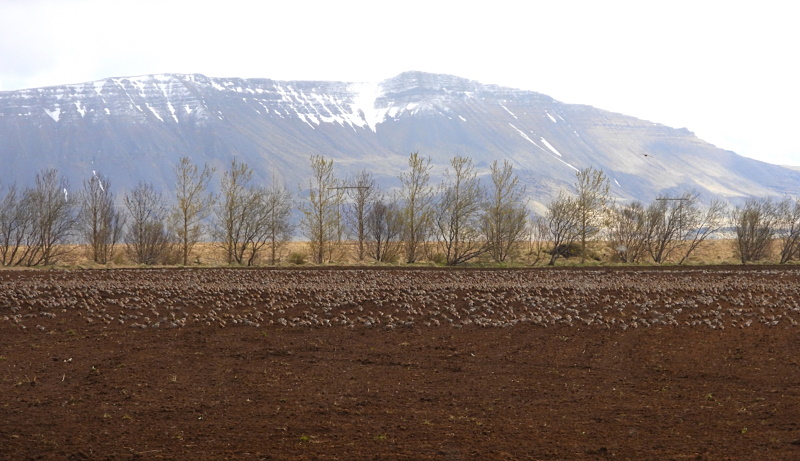
Our eight days in the field in the Southwest at sites such as at
Grunnafjörður, was very productive, thanks to farmers granting us
permission to access the flocks across their land. We found colour
marked Red Knot we had seen here in 2018. We also read 63 birds that
had been fitted with our coded orange flags on the Sefton coast, of
which 37 had previous sighting history on the Dee estuary.

They are getting ready to feed as the intertidal mussel beds are exposed. Photo Ed Keeble.

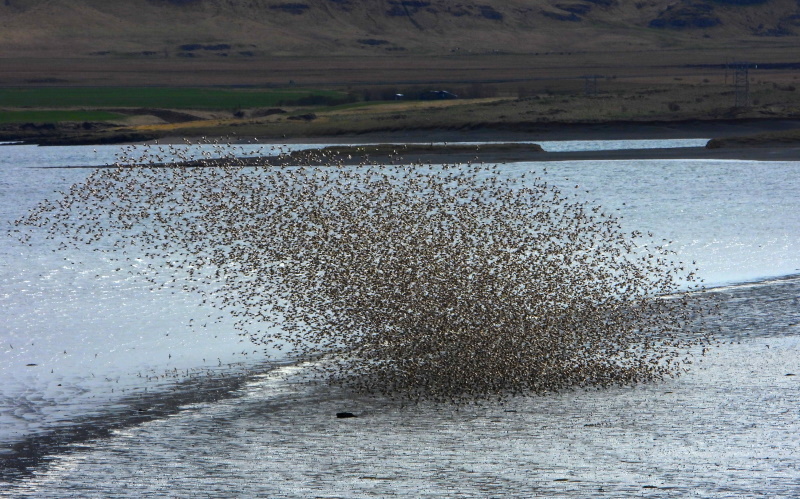
Photo Ed Keeble.
On the ninth day of our trip, we headed north to stay in Þingeyri in
Dýrafjörður. A tough 9-hour journey with over half of the 311 km on
dirt tracks that crossed up and down the mountains where there were
still snowfields. Near the end we were rewarded with views of the
spectacular Dynjandi waterfall which feeds into a fjord where colour
marked Knot can be found.
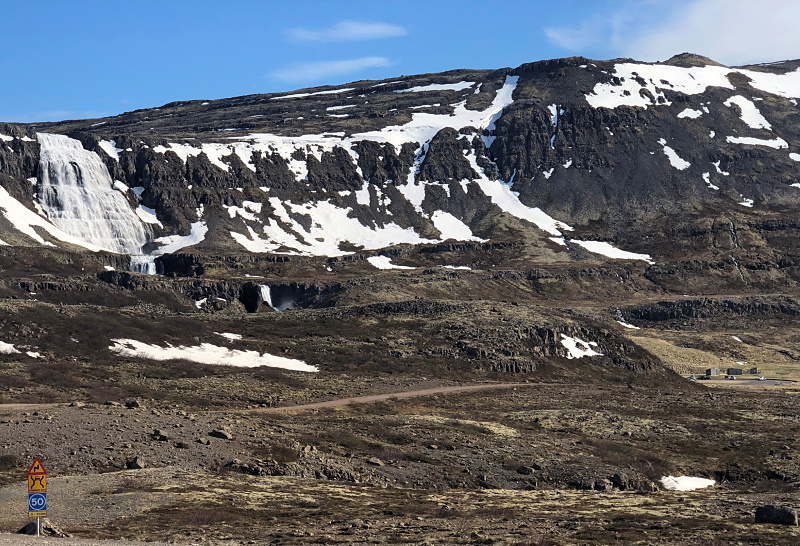
Getting colour mark readings in the Northwest of
Iceland is more
difficult as the sites used by the Knot at high tide are often a long
drive apart and if you can’t find them at one site it takes time to get
to the next site and by then the tide has gone out and the birds are
scattered among the exposed banks of seaweed. To increase our chances
of finding the Knot the group split up. We had good success at
Dýrafjörður, a well-known birding site where the Knot flocks can be
checked from the main road. However, numbers were much lower than on a
visit in 2014, but among them were several that had been colour-marked
there that year. We were mainly delighted when a Gyrfalcon swooped
through the Red Knot flock, though it caused mayhem, and lucky to be
able to study groups of Harlequin Duck up close. We were excited
when we spotted the orange flag 79E over green ring in the flock as
this was only recently ringed on the 4th March 2022 at Birkdale
Beach. A lucky observation.

in the foreground, along with the (silhouetted) Knot. Photo Peter Knight.


All in all, it was a very successful trip. The team
got complete
readings on many orange-flagged Red Knot including 100 ringed in
Liverpool Bay, 19 marked in Scotland, 2 marked in Wales, and 3 marked
in Northern Ireland. We saw a further 471 individuals from marking
schemes in Norway, Iceland, The Netherlands, Poland, the Wash and the
Humber, plus two ‘megas’: one a bird colour marked in Canada and
another from USA. The Canadian bird was particularly special for us two
as we had seen it in early January this year on the Humber at
Cleethorpes Beach, the first reading since it had been ringed in June
2007 at Alert, Ellesmere Island. Now one of our team had read it again:
just like buses it took a long time for the first colour mark reading
to arrive and it is followed quickly by a second. The USA bird had been
marked in May 2011 at the famous staging site at Delaware Bay, New
Jersey. There’s little doubt this is the Nearctic subspecies C. c. rufa
that at some point had become a transatlantic vagrant and fallen in
with its islandica cousins.
It confirms the vagrancy of one we reported
in 2018 in the same fjord (see An American Red Knot in Iceland, British
Birds, November 2018 Vol 111).
On our way back to Keflavik airport on 25th May we stopped off at
Grunnafjörður where the flock of Knot that had numbered up to 27,000 10
days earlier had diminished to 6,000. The Knot had headed off North,
but we were heading South. Back on Merseyside, the summering wader
flock has kept us entertained for the last two months as young Knot
ringed during last winter have spent their first summer with us, along
with a Norwegian Bar-tailed Godwit and Polish Grey Plover. The
excitement is now building as during the last two weeks of July the
adults have begun to return. The year starts again.
Rose Maciewicz and Peter Knight
31st July 2022
Colour Ring Report
Shelducks
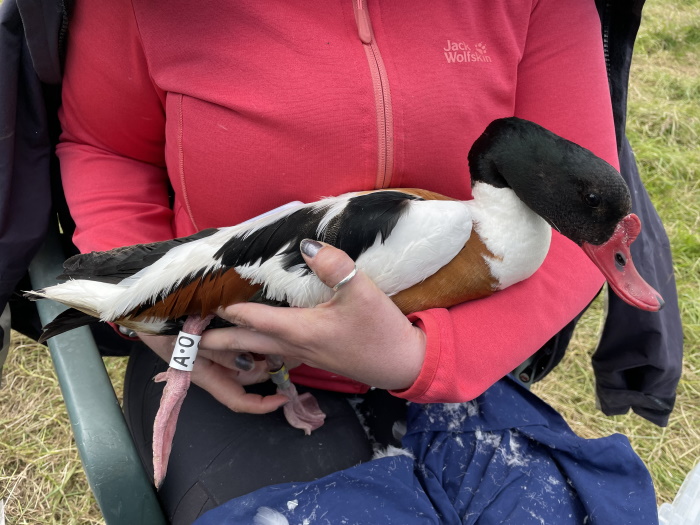
A.O on a white
ring, and fitted with a temporary GPS tracker (NOTE: the tracker falls
off when the Shelduck moults).
This adult male Shelduck was fitted with it's colour ring and a GPS
tracker on 12/6/2022 at Stangford Lough in Northern Ireland. It then
moved to the Solway Firth and fed there for 11 days. After that it
headed due south, passing both Morecambe Bay and the Ribble Estuary
without stopping before ending up in the Dee Estuary where it spent
most of it's time between Flint and Parkgate, too far from the shore to
pick out - we did try!
Just when it had convinced us it was going to moult on the Dee Estuary
about mid-July it up sticks and headed due east flying all the way to
the Waddensea.
Over the same time period another Shelduck, an immature female, was
fitted with a GPS tracker on the Tees Estuary and headed south-west
first visiting the Ribble Estuary and then the Dee Estuary. An
interesting east to west movement.
These tracked Shelduck are part of a PhD project
being carried out by Ros Green in order to get a better understanding
of Shelduck migration and movements, and in particular to assess the
impact that offshore windfarms may have on Shelducks as they migrate.
Read all about this project here: Shelducks.co.uk.

Black-headed Gulls
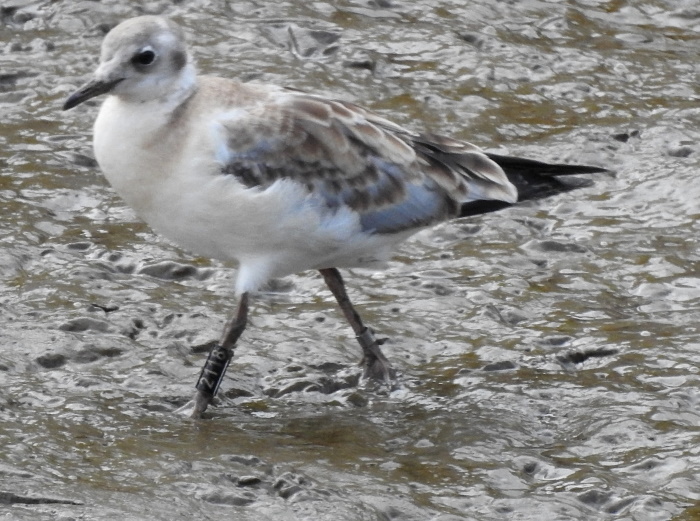
2118 on Black Ring.
Ringed at Shotton Lagoons on 10/07/2022.
Recorded at Flint Dock on 21/07/22.
175 young Black-headed Gulls were ringed at Shotton on 10/07/2022. They all have a black ring with numbers beginning with a '2'. Note that there are other schemes with black rings fitted to Black-headed Gulls but these are all a mixture of numbers and letters.
Peter Coffey of the Merseyside Ringing Group sent me
this:
"We have started a programme of colour-ringing Black-headed Gull
chicks, aiming to ring 200 chicks each year for the next three years.
The project is sponsored by Natural Resources Wales and it has three
objectives: i) to increase reported sightings of the birds away from
the colony during the non-breeding season; ii) to monitor rates of
return to natal colonies and movement between colonies in the Dee
estuary (Burton Mere Wetlands, Oakenholt); iii) working with the “Our
Dee estuary” project, encouraging school-children to follow the
journeys of birds hatched on the Dee estuary.
The colour-rings used are black with four white numbers (2xxx), placed
on the left leg of the gull. Any person sighting a black-headed gull
with this type of colour-ring can send the details directly to me at peter.coffey@zen.co.uk."

Regular readers of this colour Ring Report will recognise Black-headed
Gull TMEN,
it was ringed in Poland in 2013 and has returned to the Dee Estuary
every year since. I saw it at West Kirby on 29/07/2022 when looking at
4,000 Black-headed Gulls hoping to see some colour ringed ones among
them. I saw none until I realised the nearest gull to me was my old
friend TMEN!
Mediterranean Gulls
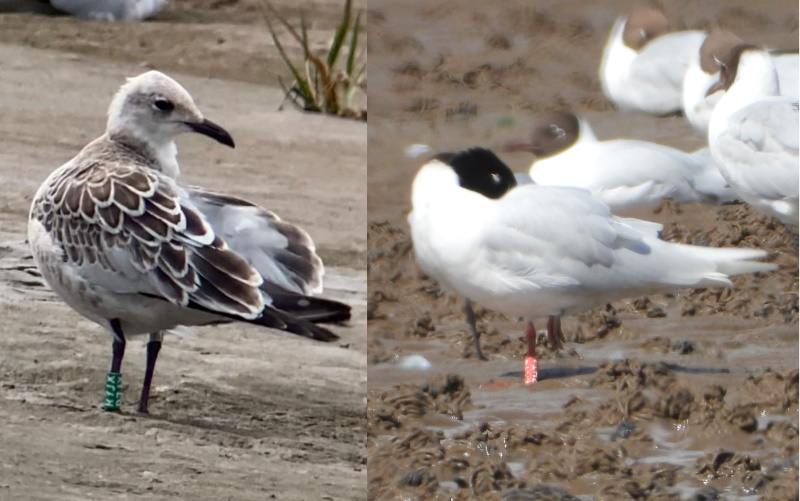
A couple of very nice colour ringed Mediterranean Gulls this month, a
French juvenile (the ringer said one of just two in the UK in July) and
a Czech ringed adult (only our second from that country).
Green Ring (R7JX)
Ringed on the Isle de Noirmoulter (west of Nantes) on the west coast of
France on 25/06/2022 as a chick.
Recorded on Hoylake Shore on 19/07/2022.
Red Ring (ZHT4)
Ringed as a breeding adult at Karvina, Ostrava, Czech Republic, on
18/5/2019.
Recorded:
On Cardigan Bay (Ceredigion) in October 2021 then on the Gann Estuary,
Pembrokshire on several dates in the winter 20/21, and then at Dale,
Pembrokshire in February 2022.
In Swidnica, Poland on 16/06/2022.
Thurstaston Shore on 30/06/2022.
A good example of the movement west from breeding areas in Germany,
Czech and Poland after breeding. This one appears to spend it's winters
in Wales but some head south towards Iberia.
Greenshank
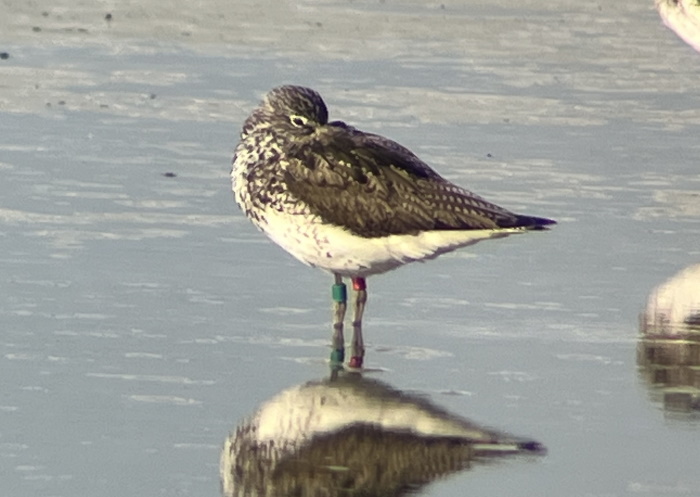
The above Greenshank was at Burton Mere Wetlands on 01/07/2022 and is the first colour ringed one in our Dee Estuary database. Unfortunately, only two out of the four rings it should have could be seen. However, the presence of a single green ring on the left tibia suggests it was ringed on Farlington Marshes in Langstone Harbour on the south coast.
Black-tailed Godwits
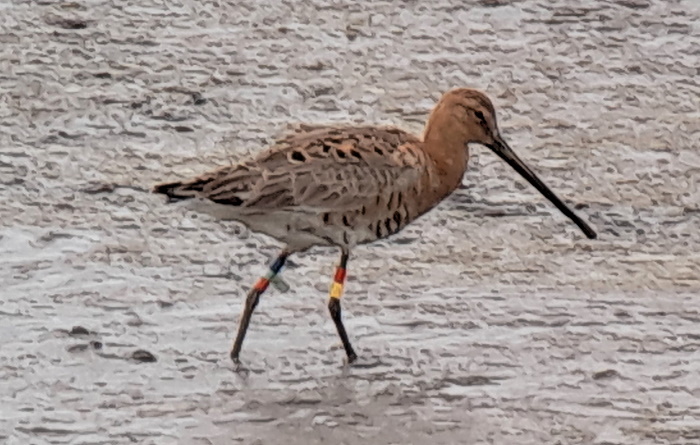
L3BRRY
Ringed in rice fields near the Tagus Estuary, Portugal, on 09/01/2019
as an adult.
Recorded:
Middleton Lakes RSPB (NE of Birmingham) on 20/04/2020 and a week later
on the Isle of Tiree, obviously on it's way to Iceland.
On it's return from Iceland it was at Cemlyn Bay, Anglesey, in early
July 2020.
It was again in rice fields by the Tagus Estuary in late winter in both
2021 and 2022.
West coast of France at Le Gorgeais in March 2022.
Oakenholt Marsh on 03/07/2022.
Although ringed in Portugal this is a Dutch project
hence the unusual code with the number '3' denoting the position of the
Lime flag in relation to the other rings. Note much of the bird rich
Tagus Estuary is threatened by a new airport.

OY-RN
Ringed at Arnabaeli, south Iceland, on 11/06/2017 as a chick.
Recorded:
At Caldy, West Kirby and Thurstaston shore many times between
07/08/2017 and 14/10/2017.
It was at Marshside and Lytham Hall on several dates during the winter
of 2017/18 before returning to Caldy in late June 2018. It was recorded
there on many dates in the autumns of 2018, 2019 and 2020 and also the
spring of 2019 and 2020. There were single records from Frodsham Marsh
in July 2020 and the Ribble Estuary in January 2021.
After that it has been more elusive with one August record from Caldy
in 2021 before it turned up at Oakenholt Marsh on 17/07/2022 and then
at Caldy on 24/07/2022.
When it was first seen in August 2017 it was one of the first juveniles
of that year to arrive from Iceland. 2017 was a very good breeding
season, reports suggest that this year, 2022, has also been good.
Sandwich Terns
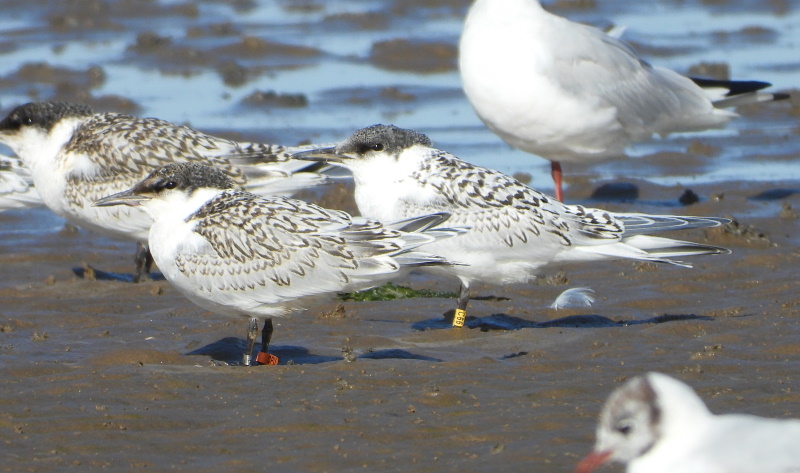
Although numbers of Sandwich Terns were relatively low in July we did
see several colour ringed birds. As we still wait for feedback on some,
and hopefully we will see more in August, I plan to do a 'Sandwich Tern
Special' for the next newsletter.
Colour Rings were recorded by Richard Smith, Stephen Hinde, Richard Whitby, Richard Speechley, Alan Hitchmough, David Bradshaw, Allan Conlin, Peter Haslem, Sean O'Hara, Alex Jones and Derek Bates.
Richard Smith
July Bird News

Lots of Mediterranean Gulls this month and 27 counted on the 12th must be at least double our previous highest count. Mediterranean Gulls have been increasing in numbers steadily over a good number of years but the surprise is actually that we don't get more here given the large numbers recorded on Cardigan Bay not far to the south. Several hundred are often seen there in late summer. Looking at BirdGuides the highest count was over 1,000 at Llanrhystud on August 30th 2020 after which BirdGuides stopped reporting Mediterranean Gulls altogether - they are a rare bird service after all!
The Common Terns at Shotton had a good breeding
season with 403 nests, above the five-year average. The Little Terns at
both Gronant and Point of Ayr had record numbers of breeding pairs but
I haven't yet heard what the the fledgling count was although I'm
expecting it to be
high. Also at Shotton there were large numbers of Black-headed Gulls
breeding with the 728 nests counted, way above any previous count. Many
of these will have moved to the estuary after breeding and we saw
thousands at Heswall, Thurstaston and West Kirby with 4,000 at the
latter being the highest count on the 29th.
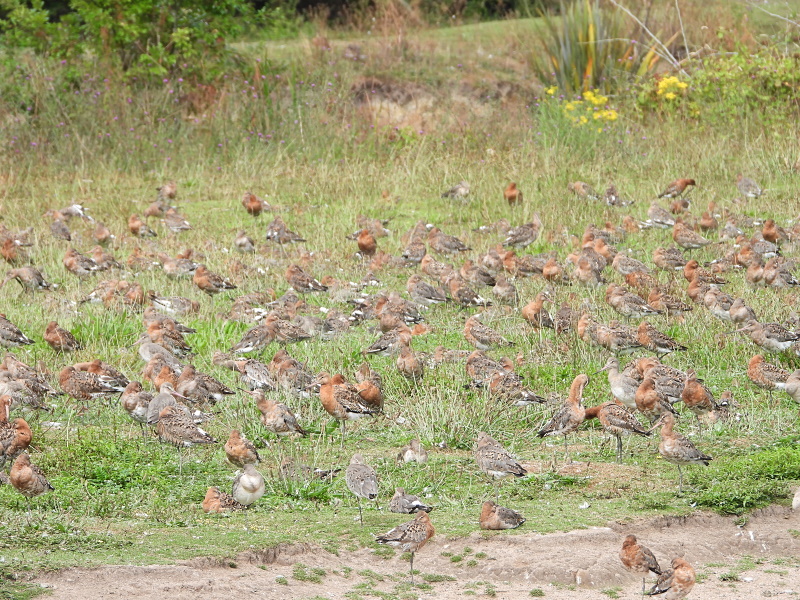
Waders returned to the estuary in good numbers and Redshank reached
over 3,000 at Heswall and 2,830 Black-tailed Godwits were at Caldy by
the month-end. Scarcer waders included 21 Common Sandpipers along the
River Dee by Connah's Quay, six Spotted Redshank at Burton Mere
Wetlands, 11 Whimbrel at West Kirby and seven Greenshank at Parkgate.

Max counts of Sandwich Terns were at least 250 at West Kirby on the 11th and 500 at Hilbre on the 24th. Mainly light winds meant sea-watching was a bit quiet but a nice fresh westerly brought 6 Arctic Skuas and 160 Manx Shearwaters past Hilbre on the 25th.
Records of more than one Red Kite together are rare
over our area so it was good to see three over Wallasey heading
north on the 17th which were also spotted flying over Seaforth. Perhaps
a family party? A probable family party of Garganey turned up right at
the end of the month at Burton Mere Wetlands - an adult pair and a
juvenile and they may well have bred at the site.

What to expect in August
There will be an awful lot going on in August, lets
start with terns and other seabirds:
All our regular tern species seem to have had a good breeding season so we should see plenty of them. Sandwich Tern numbers could reach 2,000 in total between Gronant in the west and north Wirral in the east. They usually peak in the first half of August before they start to move southwards. As the Sandwich Terns depart we will see both Common Terns and Little Terns and these could both be present in their hundreds. Point of Ayr, Hilbre and Hoylake are good spots for these. Scarcer terns which may be seen are Arctic, Black and Roseate. Westerly gales, specially towards the end of the month, can blow in lots of seabirds including all four species of skuas, Gannets and Manx Shearwaters. Both Storm and Leach's Petrels are possibilities, and Sabine's Gulls are not unknown in August.
Waders
The Dunlins we see this month are not the same ones
which over-winter here. These ones breed in Iceland and Greenland and
pass through here in August on their way to West Africa. Flocks up to
10,000 are often recorded and can be seen carpeting Hoylake shore,
together with hundreds of Ringed Plovers, on a rising tide.
One of the biggest Black-tailed Godwit post-breeding
moulting sites in the country is at Caldy Wildfowl Collection and these
could reach as many as 6,000. When they aren't feeding out on the
estuary they are easily seen from Telegraph Road (A540). What could be
the biggest flock of Redshanks in the country can be found at
Thurstaston and Heswall. Stand on the cliff top at Heswall Fields
National Trust about two hours before high tide and watch them all fly
past as they make their way to Heswall Marsh to roost. Numbers could
well reach 5,000 or more.
Towards the end of the month we can expect to see both Little Stints and Curlew Sandpipers, in their different ways both Dunlin like but the former noticeably smaller and the latter noticeably bigger and it's always exciting to pick either species out from the far more numerous Dunlin.
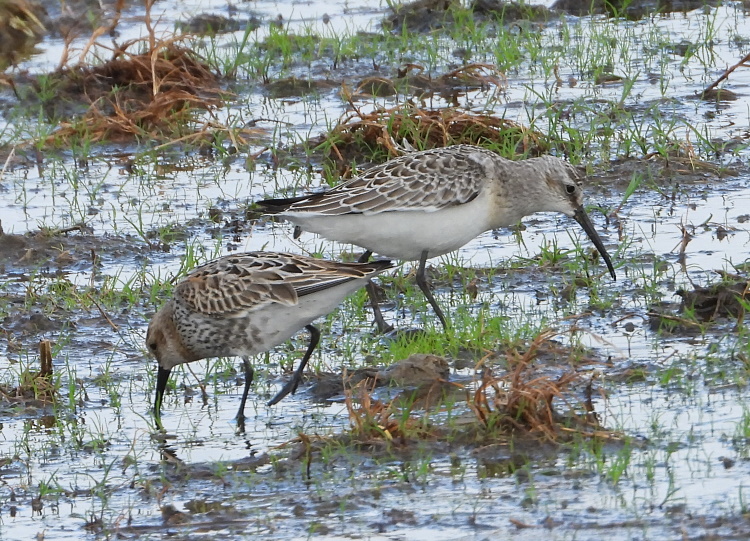
Scarce and Rare
We usually see Spoonbills this month with Parkgate
being a prime spot - they are slowly increasing in this country but I
think I'm right in saying we've never had a flock in double figures
here on the Dee, so maybe this year. Adult Cuckoos will have long gone
but the juveniles are often spotted in late summer and can be very
confiding, but PLEASE don't get too close when taking photos and spoil
it for everyone else! Look out
for returning Short-eared Owls and Hen Harriers over the marshes.
August is often good for rarities and over the last couple of years
records have included Pectoral Sandpiper, American Golden Plover, Sooty
Shearwater and Purple Heron.
Forthcoming Events
August Highest Spring Tides (Liverpool)
Also see Tides page.
13th August, 12.58hrs (BST), 9.5m.
14th August, 13.42hrs (BST), 9.5m.
Forthcoming Events
See events at https://events.rspb.org.uk/deeestuary